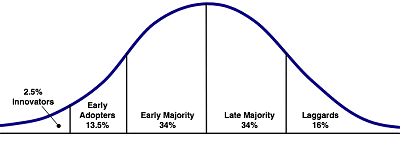It's very different to traditional management and leadership theory. The key premise is that people move through different stages with any task, no matter who or how skilled you are: it's just the speed you move through the stages that varies.
The stages are:
- The Enthusiastic Beginner/D1 (Low competence, high commitment). This is where they are very motivated and require a huge amount of support, but don't really know what they are doing.
- The Disillusioned Learner/D2 (Low competence, low commitment). This is where the person has started to realise what they don't know, but isn't there yet, and the initial enthusiasm has worn off. They can get frustrated more easily, and often feel there's little to show for their efforts.
- The Cautious Contributor/D3 (High competence, low commitment/confidence). Here, the person can do the job but don't have confidence in themselves yet.
- The Self-Reliant Achiever/D4 (High competence, high commitment). The person knows what they are doing and is self-managing.
A good way to understand the model is to think of a project away from the office such as painting your bedroom. You start full of enthusiasm, convinced it will be the most wondrous bedroom in the world when you are finished. You toy with the idea of transfers, murals and multiple tones having poured zealously over interior decorating websites and magazines, and have a plan written down. However, a few hours in, with paint dripping in your hair, splodges on the floor and one wall looking like a remnant of a sixties acid trip, you've lost all motivation. You are close to throwing the brush and phone your best friend in tears; they encourage you, telling you it'll be OK and giving you tips that you write down, such as using a roller and thinning the paint. You use their help and grimly keep going. Gradually the walls get covered more easily, and you even start correcting your early mistakes with a third coat. Your friend pops round to check you haven't committed Hari Kiri with a paint scraper to find a very credible bedroom. Impressed, they tell you so, which spurs you to finish of the edges and snagging jobs. And once you've finished, you realise that it's actually all fine, that you can do it, and you're off to paint the kitchen.
What makes this model different to a lot of leadership theory is that it asserts that each development stage has an associated leadership style that compliments the situation. The idea is that you adapt your leadership style according to where the person is in order to help them effectively; hence the idea of situational leadership rather than always having one style of management. This is where the axis of support and directive behaviour comes in. You modify the amount of direction and support, depending on where they are in that curve. The advised styles are:
- Enthusiastic Beginner/D1 = S1 Style. You need to provide specific instruction, direction and attention, like a task or check list in easy steps. They will be the ones that have lots questions regarding the task from the large to the small, but are generally full of interest and engagement.
- Disillusioned Learner/D2 = S2 Style. The person still need direction and to a lesser extent help structuring a work/task plan, but they need lots of praise and recognition for the things they do manage to ensure that their contributions are recognised and help with positive reinforcement.
- Cautious Contributor/D3 = S3 Style. The person still needs support in the form of recognition or praise, and you need to be available for brainstorming and discussion of problems, but there's a step back from the directive style to let them find their own way.
- Self-Reliant Achiever/D4 = S4 Style. This is essentially delegation; the person knows what they are doing and how to do it.
What I really like about this model is that it recognises human behaviour without judging, and offers a good management solution. No-one is expected to be immediately competent on this model, and motivation is understood to ebb and flow without censure.
It's worth noting that the model is not the easiest thing to implement, because it involves constantly being aware of where people are with regards to specific projects, and they can easily be a D4 in one task, and D1 in another related topic simultaneously. As a manager, you need to be able to pick up the cues when discussing various projects, and accepting the need to be agile as you move around topics. But if you can track where people are on the curve, then it enables you to support them in the most appropriate way.
The other thing about the model is that it offers a neutral and safe language to approach issues that could be potentially painful going forwards. This is why I shared it with my team: it's a lot easier to go to a manager and say “please stop delegating at me! I'm currently a D2 with this project!”, or “I don’t need a task list but I’d quite like to chat things through before I go ahead: I'm feeling a bit D3?” that to have to admit to feeling lost or lacking in any enthusiasm. We're going to try and use it as a mutual language, and see how it works.
Wish me luck!


